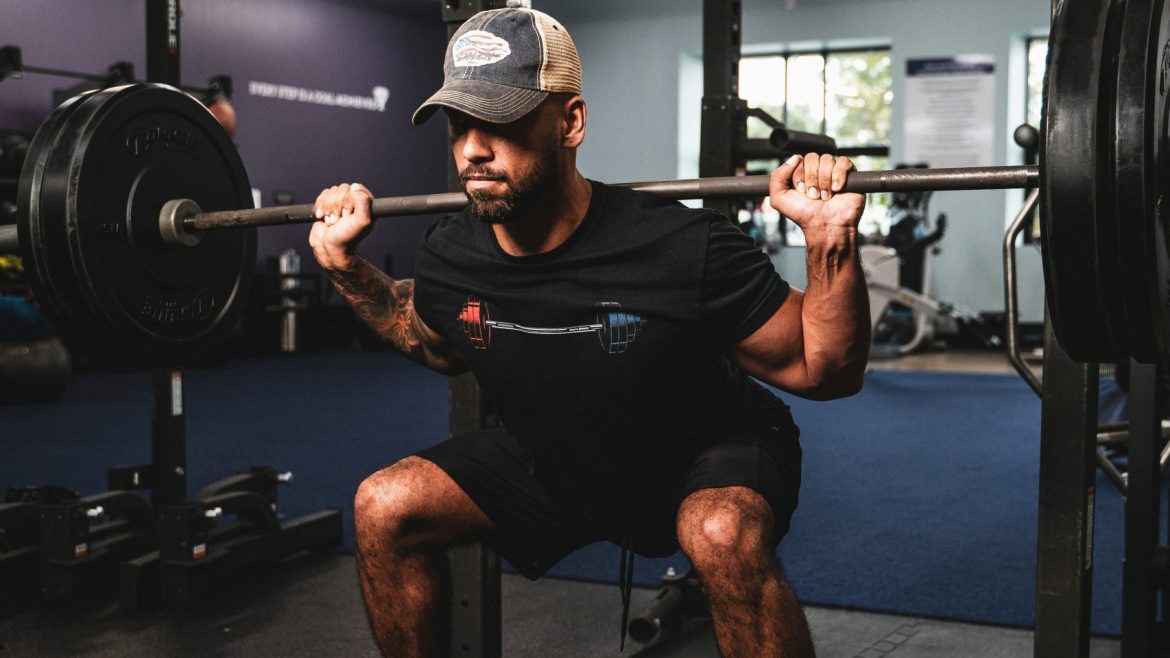Undergoing a body transformation from being underweight to significantly increasing muscle mass and body weight involves a comprehensive approach that includes diet, exercise, and lifestyle changes. This article focuses on the journey of an individual who successfully added 70 pounds, providing insights and strategies for others aiming for a similar transformation. It’s designed to offer practical advice and information for fitness beginners interested in muscle and weight gain.
Transforming from skinny to muscular requires a detailed plan that encompasses understanding nutritional needs, adhering to a structured workout program, and committing to long-term lifestyle changes. For individuals beginning their fitness journey, this transformation is not solely about physical changes but also involves learning about effective nutrition and exercise strategies.
Interesting Fact: Muscle memory plays a crucial role in fitness transformations. It allows individuals who have previously gained muscle to regain strength and size more quickly after a period of inactivity, compared to those who are building muscle for the first time.
Main Topics Covered:
- Starting Your Transformation Journey: Understanding the commitment required and setting achievable goals is crucial for a successful transformation.
- Nutrition Fundamentals for Gaining Weight: A caloric surplus, combined with a balanced diet rich in proteins and other nutrients, is essential for muscle and weight gain.
- Effective Workout Plans for Mass Gain: Implementing a workout routine that includes strength training and the principle of progressive overload is vital for building muscle mass.
- Tracking Progress and Adjusting Your Plan: Regularly monitoring progress and making necessary adjustments to the diet and workout plan is important for continuous improvement.
- Motivation and Consistency: Maintaining motivation and adhering to a consistent routine are key factors in achieving a successful transformation.
In conclusion, the journey from skinny to muscular involves a comprehensive approach that includes setting realistic goals, understanding nutritional needs, following a structured workout program, and maintaining motivation and consistency. This article provides a guide for individuals looking to embark on their own transformation journey, offering practical advice and insights into the strategies needed for success.
Starting Your Transformation Journey
Undergoing a body transformation requires a multifaceted approach, focusing on goal setting, preparation, and commitment, along with an understanding of one’s body type. This section offers a structured guide for beginners aiming to navigate the initial stages of their fitness transformation effectively.
Setting Realistic Goals
A critical first step in a body transformation is establishing realistic, achievable goals. These goals serve as a roadmap, guiding individuals through their fitness journey. The process involves assessing current fitness levels, resources, and lifestyle to set short-term objectives leading to long-term aspirations. Goals should be SMART: Specific, Measurable, Attainable, Relevant, and Time-bound. This approach ensures that objectives are clear and actionable, increasing the likelihood of success.
“An interesting fact about setting realistic goals is that individuals who set SMART (Specific, Measurable, Achievable, Relevant, Time-bound) goals are up to 2.5 times more likely to achieve their fitness objectives than those who do not.”
Preparation and Commitment
Preparation for a body transformation extends beyond the physical aspects of diet and exercise; it includes mental readiness and lifestyle adjustments. Effective preparation entails researching and planning suitable workout routines and nutrition strategies that align with one’s goals and body type. This stage is crucial for creating a conducive environment for success.
Commitment to the transformation process is manifested through consistent efforts towards goal attainment. It involves adhering to the planned workout and nutrition regimen, even when faced with challenges or slow progress. The term “Fitness Preparation and Commitment” highlights the necessity of dedication and perseverance for beginners embarking on their fitness journey.
Understanding Your Body Type
Tailoring your fitness plan to your body type can significantly enhance the effectiveness of your transformation efforts. Body types, or somatotypes, include ectomorphs, mesomorphs, and endomorphs, each with distinct characteristics affecting response to diet and exercise.
- Ectomorphs: Naturally lean, struggle to gain muscle and fat.
- Mesomorphs: Naturally muscular, gain muscle and burn fat easily.
- Endomorphs: Naturally higher body fat, gain muscle and fat easily but struggle to lose fat.
Initiating a body transformation journey effectively involves setting realistic goals, thorough preparation and unwavering commitment, and an understanding of your body type to tailor your approach. These foundational steps lay the groundwork for a successful transformation, guiding individuals towards achieving their fitness objectives. As we progress into more detailed discussions on nutrition, exercise routines, and motivation, these initial steps remain central to navigating the path to a successful and sustainable body transformation.
Nutrition Fundamentals for Gaining Weight
Nutrition plays a critical role in the process of gaining weight and building muscle, especially for individuals aiming to transition from a skinny physique to a more muscular one. This section outlines the essential nutritional strategies necessary for achieving a significant increase in muscle mass, emphasizing the importance of a caloric surplus, protein-rich diet, and strategic meal planning.
Caloric Surplus for Weight Gain
Creating a caloric surplus is paramount for anyone looking to gain weight. This involves consuming more calories than the body burns through daily activities and metabolic functions. A surplus of calories provides the energy required for the body to build new muscle tissue.
To establish a caloric surplus effectively, it is crucial to prioritize nutritious, high-calorie foods. These foods not only contribute to muscle growth but also ensure that the overall health remains optimal.
Here’s a simplified table listing examples of high-calorie foods beneficial for muscle gain:
| Food Type | Examples | Benefits |
|---|---|---|
| Healthy Fats | Avocados, nuts, and seeds | High in calories, support hormone production |
| Whole Grains | Quinoa, brown rice, oatmeal | Provide sustained energy, rich in fiber |
| Lean Proteins | Chicken, fish, legumes, tofu | Essential for muscle repair and growth |
| Dairy Products | Milk, cheese, Greek yogurt | High in protein and calcium |
Protein-Rich Diet for Muscle Gain
Protein is essential for the repair and growth of muscle tissue, making it a vital nutrient in any muscle-building diet. The amino acids in protein act as the building blocks for new muscle, crucial for recovery and development after exercise.
“An essential fact about protein intake for muscle gain: Consuming protein within 30 minutes after exercising significantly increases muscle synthesis, optimizing recovery and growth.”
Meal Planning Tips
Consistent meal planning is key to maintaining a caloric surplus and ensuring sufficient protein intake. It requires organizing meals to meet nutritional goals effectively, facilitating weight gain and muscle growth.
Effective meal planning strategies include:
- Preparing meals ahead of time to avoid opting for less nutritious, convenient options.
- Ensuring a variety of nutrient-dense foods are included in the diet to meet all dietary needs.
- Eating regularly to provide a constant nutrient supply to the muscles.
Adopting these practices helps in adhering to nutritional goals, making it easier to achieve and maintain a caloric surplus. Utilizing tools like calorie tracking apps can also assist in monitoring intake and ensuring nutritional targets are met.
A well-structured nutritional strategy is essential for anyone looking to gain weight and build muscle. By focusing on creating a caloric surplus with nutritious, high-calorie foods, optimizing protein intake, and employing effective meal planning techniques, individuals can significantly enhance their muscle growth and overall health.
Effective Workout Plans for Mass Gain
Designing an effective workout plan is pivotal for individuals focused on gaining muscle mass. This segment offers a detailed examination of essential elements in a mass gain workout regimen, emphasizing strength training, the application of progressive overload, and the critical importance of recovery and rest.
Strength Training Basics
Strength training is essential for muscle growth, involving exercises that induce muscle contraction against resistance. This leads to hypertrophy, strength increases, and enhanced endurance. For beginners, comprehending strength training’s fundamental exercises and principles is vital.
Key compound movements are integral to mass gain:
- Squats: Target the quadriceps, hamstrings, glutes, lower back, and core.
- Deadlifts: Engage the back, glutes, legs, arms, and core.
- Bench Presses: Work the chest, shoulders, and triceps.
- Pull-ups: Strengthen the back, shoulders, and arms.
Incorporating “Mass Building Workouts” and “Strength Training for Beginners” should initially focus on proper form and technique to prevent injuries. Starting with lighter weights and gradually increasing as strength improves is recommended.
Progressive Overload Principle
Progressive overload is a foundational concept in strength training, essential for continuous muscle growth. It involves the gradual increase of stress on the muscles, necessitating adaptations that foster growth and strength.
“Interesting Fact: The concept of progressive overload was popularized by Dr. Thomas Delorme in the 1940s as a method to rehabilitate soldiers during World War II, showcasing its foundational role in strength training.”
Effective application of “Progressive Overload Technique” includes incrementally raising the weight, enhancing the frequency, or augmenting the number of repetitions in workouts. Adjustments should push the muscles beyond their current capacity, prompting adaptation and growth.
Recovery and Rest
Recovery and rest are paramount for muscle development, as muscles repair, rebuild, and strengthen during these periods. Optimal growth occurs during rest, necessitating adequate rest days in any workout schedule.
Effective “Muscle Recovery Strategies” involve ample sleep, crucial for growth hormone release and repair, and active recovery days. Light exercises such as walking or yoga can facilitate muscle recovery and maintain flexibility without excessive strain.
Conclusively, an all-encompassing workout plan that prioritizes strength training basics, employs progressive overload, and incorporates sufficient recovery and rest is fundamental for significant muscle mass gains. Adhering to these principles, along with strategic nutrition and consistent effort, ensures the realization of mass gain objectives, culminating in a more muscular and defined physique.
Tracking Progress and Adjusting Your Plan
Effective tracking and timely adjustments are essential for maximizing the outcomes of a fitness plan. This section provides a comprehensive overview of the methodologies for monitoring fitness progress, techniques to break through plateaus, and the significance of feedback loops in optimizing workout and diet plans.
Monitoring Your Transformation
Accurate tracking of fitness progress is crucial in evaluating the success of your workout and diet strategy. Various methods exist for this purpose, each offering unique insights into your journey.
| Tracking Method | What It Measures | Benefits |
|---|---|---|
| Digital Apps | Workouts, Diet, Progress Photos | Convenient, comprehensive data collection |
| Fitness Trackers | Physical Activity, Heart Rate, Sleep Patterns | Real-time monitoring, health insights |
| Traditional Journaling | Daily Intake, Exercise, Body Measurements | Personalized, reflective approach |
These “Fitness Tracking Methods” serve as invaluable tools in documenting and analyzing your progress, enabling you to make informed decisions about future strategies.
Overcoming Plateaus
Hitting a plateau can be a common yet frustrating part of any fitness regimen. It signifies that your body has adapted to the current level of physical stress and requires new challenges to continue growing.
“Fact: Muscle adaptation to a workout regimen can occur within 6 to 8 weeks, necessitating changes to continue progress.”
To “Overcome Workout Plateaus,” it’s important to introduce variations in your workout intensity, frequency, or type. Modifying your dietary intake can also play a crucial role in pushing past these standstills, ensuring your nutrition supports your elevated fitness goals.
Feedback Loops
The implementation of feedback loops is crucial in the continuous improvement of your fitness plan. Regularly assessing your progress against set benchmarks allows for the identification of areas that need adjustment.
Feedback loops involve a cycle of planning, executing, reviewing, and refining. This process enables the dynamic tuning of workout intensities, nutritional plans, and recovery periods based on actual performance and outcomes. Such “Adjusting Workout and Diet Plans” ensures that your regimen remains effective and aligned with your evolving fitness goals.
Diligent tracking, strategic adjustments to overcome plateaus, and the incorporation of feedback loops are foundational to the success of a fitness transformation. These strategies ensure a tailored approach to fitness, allowing for constant adaptation and optimization of your workout and diet plan.
Motivation and Consistency
Fostering motivation and ensuring consistent effort are pivotal for long-term success in any fitness journey. This section outlines practical approaches for building a robust support system, strategies to maintain motivation, and the significance of prioritizing consistency over the pursuit of perfection in workouts.
Building a Support System
Having a supportive community plays a vital role in staying motivated and accountable towards your fitness goals.
“A study found that those with a solid support system in place were 65% more likely to complete a fitness program compared to those who went at it alone.”
Engaging with fitness groups, both online and offline, or partnering with a workout buddy can offer the encouragement and accountability needed to persevere. These connections not only provide emotional support but also serve as a resource for sharing knowledge and experiences, thereby enriching your fitness routine.
Staying Motivated
Keeping motivation high is essential for continuous engagement with your fitness regimen. Effective strategies to maintain motivation include:
- Setting specific, measurable goals to track progress.
- Celebrating every achievement to recognize your journey’s milestones.
- Incorporating variety into your workouts to keep the routine engaging.
- Keeping a fitness journal to visually document your progress and adjustments needed.
Implementing these tactics can help sustain interest and commitment to your fitness goals, ensuring that motivation remains strong over time.
Consistency Over Perfection
The quest for perfection in exercise routines can often hinder progress. Emphasizing “Consistency in Workouts” is crucial for making sustainable gains over time. Consistent efforts, even on days when performance is not at its peak, contribute significantly to long-term fitness achievements. Establishing a workout schedule that integrates seamlessly into your daily life and adhering to it can foster habits conducive to ongoing fitness efforts. It’s important to recognize that fitness improvement is a gradual process, with progress being measured across extended periods rather than through isolated instances of perfection.
In summary, the integration of a supportive network, maintenance of high motivational levels, and a focus on consistency form the cornerstone of achieving fitness objectives. These elements, supported by actionable strategies and factual insights, lay the groundwork for a successful and enduring fitness journey. By applying these principles, individuals can navigate the path towards their fitness goals with greater confidence and resilience, ensuring that motivation and consistency remain central to their efforts.
Conclusion: Body Transformation
Achieving a significant body transformation encompasses more than just frequent visits to the gym. It requires a holistic approach that combines strategic nutrition, meticulously planned workout routines, consistent monitoring of progress, and an unwavering commitment to sustaining healthy habits.
“Implement these strategic insights into your daily routine, from setting realistic goals to maintaining motivation and consistency. Let each step forward bring you closer to your ultimate health and fitness aspirations. Start today — your future self will thank you.”
Essential Strategies for a Successful Fitness Journey:
- Realistic Goal Setting: Initiating your journey with attainable objectives tailored to your unique body type and fitness level.
- Nutritional Planning: Emphasizing the importance of a caloric surplus and a protein-rich diet to fuel muscle growth and recovery.
- Workout Routine Development: Incorporating strength training with progressive overload and allowing for sufficient recovery to build muscle effectively.
- Progress Monitoring: Utilizing various methods to track fitness advancements and making necessary adjustments to your regimen.
- Sustaining Motivation and Consistency: Engaging with a support network to stay motivated and maintaining consistent effort in your workouts.
By adopting a multifaceted approach that covers effective workout plans, nutritional strategies, and motivational techniques, individuals can navigate the complexities of fitness transformations with greater success. Remember, the integration of thoughtful planning and consistent effort forms the bedrock of lasting health and fitness achievements. Let this guide serve as your blueprint for a future where fitness and well-being are not just goals but a way of life.
Citations:
- How we Went From Skinny to Muscular (+70 Pounds of Muscle), Bony to Beastly, Bony to Beastly
- Body Transformation: Cody Przybylski Grew Tired Of Being The Tall Skinny Kid, Muscle & Strength
- Proven Strategy: How to Build Lean Muscle for Skinny Guys [Real-Life Case Study], Strength Matters
- Personal Trainer Explains How He Put on 40kg of Muscle and Went from Skinny to Stacked, Men’s Health


